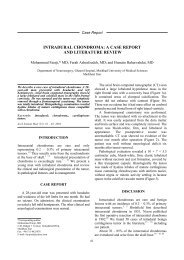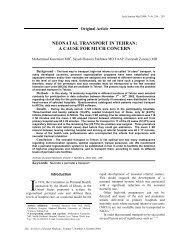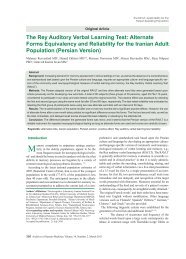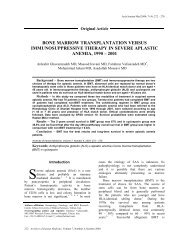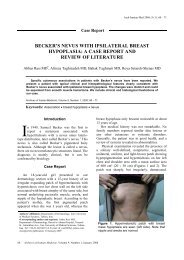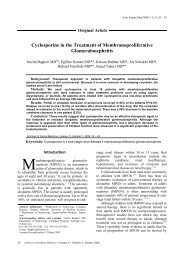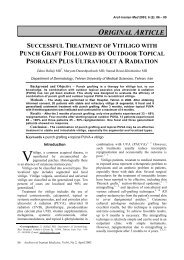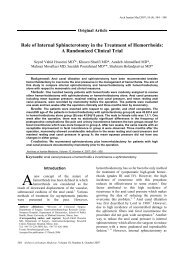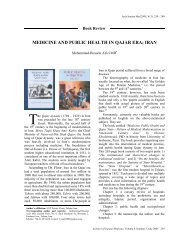COMPARISON BETWEEN EPIDURAL MORPHINE VERSUS ...
COMPARISON BETWEEN EPIDURAL MORPHINE VERSUS ...
COMPARISON BETWEEN EPIDURAL MORPHINE VERSUS ...
You also want an ePaper? Increase the reach of your titles
YUMPU automatically turns print PDFs into web optimized ePapers that Google loves.
Arch Iranian Med 2003; 6 (2): 81 – 85ORIGINAL ARTICLE<strong>COMPARISON</strong> <strong>BETWEEN</strong> <strong>EPIDURAL</strong> <strong>MORPHINE</strong><strong>VERSUS</strong> <strong>MORPHINE</strong> + FENTANYL IN LUNGRESECTION SURGERYBadiozaman Radpay MD • , Shahram Karimi-Zandi MD, Shideh Dabir MD, Tahereh Parsa MDDepartment of Anesthesiology and Critical Care Medicine, National Research Institute ofTuberculosis and Lung Disease, Shaheed Beheshti University of Medical Sciences, Tehran, IranBackground – Use of narcotics in the epidural space has dramatically changed patient careafter surgery because it provides suitable analgesia with fewer complications than othermethods. Morphine is a narcotic widely used in the epidural space for pain management, but itsuse is associated with several complications such as urinary retention, nausea, and vomiting.This study was designed to determine whether the addition of fentanyl to epidural morphinewould reduce the associated complications.Methods – Of patients prepared for lung surgery, 72 were selected for epidural analgesia.Twelve patients met the exclusion criteria, but the remaining patients were randomized in adouble-blind manner to receive morphine plus fentanyl (n = 30) or morphine alone (controlgroup; n = 30). Drugs were injected when requested by patients , when the visual and verbalpain scores reached 2. Vital signs were checked and complications were recorded in apredefined questionnaire.Results – At the end of the study, there was a higher prevalence of complications in themorphine group than in the morphine plus fentanyl group (p < 0.05). There was no significantdifference in analgesic time between the two groups, and analgesic time was more thanexpected in the morphine plus fentanyl group (p < 0.000).Conclusion – The results of this study showed that adding fentanyl to morphine in epiduralanalgesia can reduce the complications with at least equal analgesic time. Thus, we canconsider this combination as a good choice for epidural analgesia in thoracotomy patients.Keywords • anesthesia • analgesia • epidural morphine • lung surgeryIntroductionThe use of epidural narcotics hasdramatically changed patient care aftersurgery because it provides suitableanalgesia with fewer complications than othermethods. Morphine administration to the epiduralspace can provide effective pain relief after mostsurgical procedures, such as thoracic andabdominal surgery and limb amputation. 1, 2However, the pain relief is often accompanied by ahigh incidence of side effects. 3 – 5Fromme et al compared lumbar morphine withthoracic morphine for relief of postthoracotomy•Correspondence: B. Radpay MD, Department of Anesthesiologyand Critical Care Medicine, Shaheed Beheshti University of MedicalSciences, Tehran, Iran. Fax: +98-21-2280500, E-mail:radpay@hotmail.com.pain and concluded that the thoracic approach wasmore useful. 6 However, we could not find anystudies of morphine versus morphine plus fentanylfor thoracotomy pain relief. In an attempt todecrease the side effects of epidural morphine, thenarcotic fentanyl was added to morphine andadministered as mixed doses to the epidural spacefor pain relief in postoperative thoracotomypatients.Patients and MethodsSeventy-two patients scheduled to undergopulmonary resection between October 1999 andOctober 2000 were scheduled to receive epiduralanalgesia. Of these, 60 were randomized into twogroups, following the approval of the ethicscommittee of Masih Daneshvari Hospital. TheArchives of Iranian Medicine, Vol 6, No 2, April 2003 81
Epidural Morphine vs Morphine + Fentanyl in Lung Resection SurgeryFigure 1. Visual pain analogue. 1advantages and probable disadvantages of thetreatments were completely explained toparticipants before they gave informed consent.At the end of surgery, patients were placed inthe lateral position and an epidural catheter wasinserted in the L 3 -L 4 or L 4 -L 5 lumbar epiduralspace. At the end of insertion, catheters werechecked for correct position by administering 3 mLlidocaine 2% with epinephrine 1:200,000.Morphine (30 patients, Group M) or morphine plusfentanyl (30 patients, Group MF) was slowlyinjected.In Group M, the first injection of morphine was0.05 mg/kg morphine sulfate in 20 mL normalsaline, while the same dose in 10 mL normal salinewas used for subsequent injections. In Group MF,the initial injection was 0.25 mg/kg morphinesulfate plus 0.00125 mg/kg fentanyl in 20 mL ofnormal saline, while the same dose was used in 10mL of normal saline for subsequent injections.The agents were administered at the patient’srequest, but at intervals of not less than 1 hour.Four-hourly follow-up started at the first injection.This was provided by a team of five nurseanesthetists, both in the intensive care unit and thesurgical ward. If any complications were detected,naloxan 0.2 mg was injected intravenously and thiswas recorded in the patient’s file. During the studyperiod, patients were assessed for pain intensityevery 6 hours using both a visual pain analogue(VPA) and a verbal pain analogue (WPA) scale(Figures 1 and 2).Two pain scales (VPA and WPA) were used toreduce bias, which might have occurred if either ofthese systems were applied separately. The healthcare team was blinded to the drugs used. Duringthe 3 days of follow-up, patients were asked forsymptoms of probable opioid overdose, such aspruritus and catheter-related complications, andother pains (muscle pain, incisional pain, etc.)Catheter tips were checked for an intact headafter removal from the epidural space at the end ofthe 3-day follow-up.Chi-square, Student’s t (p < 0.05) and Fisher’sexact tests were used to determine thecomparability of the treatment groups. Both paincomplications and the length of pain-free periods,determined from the pain questionnaire, wereanalyzed. Results of Chi-square tests wereconsidered significant at 0.05 or less. There was nosignificant difference in the duration ofpainlessness in each group, so the Student’s t-testwas used to test the mean duration of pain reliefinterval and the Chi-square test was used toanalyze complications, that is, if the p value was0.05 or less in any mentioned test, it would bemeaningful.%5040302010MorphineMorphine + Fentanyl00 1 2 3 4 5Number of complicationsFigure 2. Frequency of the number of complications in two groups.82Archives of Iranian Medicine, Vol 6, No 2, April 2003
B. Radpay, S.K. Zandi, S. Dabir, et alTable 1. Distribution of the two groups by age.Patient/AgeA B Total(yr) F (n) % F (n) % F (n) %5 – 15 1 3.2 2 7.7 3 5.315 – 25 4 12.9 3 11.5 7 12.325 – 35 7 22.6 6 23.1 13 22.835 – 45 8 25.8 4 15.4 12 21.145 – 44 5 16.1 2 7.7 7 13.3> 55 6 19.4 9 34.6 15 26.3Total 31 54.4 26 45.6 57 100A = morphine group; B = morphine + fentanyl group; F = frequency.ResultsThree patients were excluded from theexperiment because of a malpositioned epiduralcatheter in both groups. Of the 57 patients, mostwere males [31 (58%) in Group M and 26 (64%) inGroup MF]. There was no significant differencebetween the groups in age and sex (p = 0.65)(Table 1).Females in Group M had statistically morecomplications than females in Group MF (p =0.02).The number, percentage and validity of eachcomplication are shown in Figure 2. There was atrend towards not statistically significant morecomplications in Group M than Group MF (Table2). 2 In Group M, 71% of patients had at least onecomplication, while in Group MF, this figure was50%. There was a statistically significantdifference between females in Group MF andfemales in Group M (92.3 % vs 50%, p < 0.05).These results show that the combination ofmorphine and fentanyl had greater efficacy inTable 2. Frequency of complications in two groups.Treatmentgroups/ComplicationsAfemales than in males. In addition, low back painduring epidural injection was more frequent inGroup M than Group MF. However, the onlymeaningful statistically significant complicationwas related to other pains (i.e. incisional pain,radiculopathy, etc).DiscussionInitially, the duration of analgesia (analgesictime) was not considered important, but wasmeasured as a quantitative variable. It wasexpected that patients in Group MF would have amuch shorter analgesia than those in Group M. 7Because the dose of morphine in Group MFwas half that in Group M and fentanyl (duration ofaction, 1.5 – 3 hours) was used as an adjuvant tomorphine in Group MF, the expected analgesictimes in Groups M and MF were 4.5 and 6 hours,respectively. 7 However, the analgesic time was 8± 4.8 hours in Group M and 9 ± 4.5 hours in GroupMF (Table 1), an increase of 2 and 4.5 hours,respectively, over the expected analgesic times.No. % No. %Bp ValueLow back pain 12 37.7 7 25 0.26Headache 1 3.2 1 3.6 0.72Other pains 5 16.1 0 0 0.034*Flushing 5 16.1 2 7.1 0.428Nausea and Vomiting 6 19.4 3 10.7 0.477Pruritus 9 29 4 14.3 0.172Urinary retention 6 19.4 5 17.9 0.883Total 22 71 14 50 0.09A = morphine group; B = morphine + fentanyl group; *p < 0.05.Archives of Iranian Medicine, Vol 6, No 2, April 2003 83
Epidural Morphine vs Morphine + Fentanyl in Lung Resection SurgeryThus the extended was enhanced is 9 ± 4.5 hours, adifference of 5.5 hours. Thus, the pain-free periodwas longer in Group MF than in Group M (p 0.05).There was no statistically significant differencebetween the groups in complication rate, other thanthe incidence of radiculopathy and incisional pain.This was due to various factors. There was alimited number of thoracotomy cases and casegathering took more than 14 months. This samplescattering over a long period of time reduced theinternal validity, hence it would have been better ifthe experiment had been carried out over a specificlimited period.In order to reduce complications in both groups,the lowest doses of both morphine (0.05 mg/kgmorphine in Group M and 0.025 mg/kg morphinein Group MF) and fentanyl (0.00125 mg/kg) wereused. Had the recommended dose of 0.1 mg/kgmorphine been used, the complication rates wouldhave been dramatically increased and anysignificant differences would have been moreeasily detected.The complication rate in females in Group MFwas lower than that of females in Group M (50%vs 92.3%; p = 0.02). Thus, the MF regimen can beprescribed for females undergoing thoracotomy.More patients in Group M than Group MFdiscontinued epidural therapy. This may have beenbecause the time to onset of action of morphine is20 minutes compared with 5 minutes for fentanyl 7and because of the higher frequency of low backpain in Group M after injection. There were fewercomplaints of low back pain in Group MF than inGroup M because it took about 20 minutes inGroup M to suppress the pain caused by dilation ofthe epidural space during forceful injectioncompared with 5 minutes in Group MF.In summary, there was a longer duration of painreduction (5 hours vs 2 hours in Groups MF andM, respectively) (p < 0.000) and faster onset ofaction in Group MF than in Group M.In addition, there was a higher complicationrate in Group M than in Group MF (p > 0.05);complication rates were significantly lower infemales in Group MF than in females in Group M(p = 0.02).Nonetheless, more cases are needed to evaluatewhether all of the useful items discussed can beattributed solely to fentanyl or whether otherunknown factors are involved.AcknowledgmentThe authors would like to thank Dr. HamidrezaMohammadi for statistics analysis and Mr.Doustali for clerical work on this article.References1 Hered RW, Cummings RJ, Helffrich R. PersistentHorner’s syndrome after spinal fusion and epiduralanesthesia: a case report. Spine. 1998; 23: 387 – 90.2 Goodarzi M. Comparison of epidural morphine,hydromorphone and fentanyl for postoperative paincontrol in children undergoing orthopaedic surgery.Paediatr Anaesth. 1999; 9: 419 – 22.3 El-Baz NML, Faber LP, Jensik RJ. Continuous epiduralinfusion of morphine for treatment of pain after thoracicsurgery: a new technique. Anesth Analg. 1984; 63: 757 –64.4 Bonica JJ. The Management of Pain. 2nd ed.Philadelphia: Lea & Febiger; 1990.5 Shiihara K, Kohno K, Kosaka Y. Postoperative epiduralanalgesia after upper abdominal surgery: the effects oflow concentrations of bupivacaine combined with lowdoses of opioid [in Japanese]. Masui. 1999; 48: 731 – 8.6 Fromme GA, Steidl LJ, Danielson DR. Comparison oflumbar and thoracic epidural morphine for relief ofpostthoracotomy pain. Anesth Analg. 1985; 64: 454 – 5.7 Stoelting RT, Miller RD. Basics of Anesthesia. 4th ed,New York: Churchill Livingstone; 2000.8 Swenson JD, Hullander RM, Bready RJ, et al. Acomparison of patient-controlled epidural analgesia withsufentanil by lumbar versus thoracic route afterthoracotomy. Anesth Analg. 1994; 78: 215 – 8.9 Coe A, Sarginson R, Smith MW, et al. Pain followingthoracotomy. A randomized, double-blinded comparisonof lumbar versus thoracic epidural fentanyl. Anaesthesia.1991; 46: 918 – 21.10 Logas WG, El-Baz N, El-Ganzouri A. Continuousthoracic epidural analgesia for postoperative pain relieffollowing thoracotomy: a randomized prospective study.Anesthesiology. 1987; 67: 787 – 91.11 Conacher ID, Paes ML, Javolson L. Epidural analgesiafollowing thoracic surgery. Anaesthesia. 1983; 38: 546 –5 1.12 Berti M, Fanelli G, Casati A, et al. Comparison betweenepidural infusion of fentanyl/bupivacaine and morphine/bupivacaine after orthopaedic surgery. Can J Anaesth.1998; 45: 545 – 50.13 Ozalp G, Guner F, Kuru N, et al. Postoperative patientcontrolledepidural analgesia with opioid bupivacainemixtures. Can J Anaesth. 1998; 45: 938 – 42.14 Wu CL, Jani ND, Perkins FM, et al. Thoracic epiduralanalgesia versus intravenous patient-controlled analgesiafor the treatment of rib fracture pain after motor vehiclecrash. J Trauma. 1999; 47: 564 – 7.15 Khan L, Baxter FJ, Dauphin A, et al. A comparison ofthoracic and lumbar epidural techniques for post-84Archives of Iranian Medicine, Vol 6, No 2, April 2003
B. Radpay, S.K. Zandi, S. Dabir, et althoracoabdominal esophagectomy analgesia. Can JAnaesth. 1998; 19: 178 – 89.16 Bowdle TA. Adverse effects of opioid agonistantagonistsin anaesthesia. Drug Saf. 1998; 19: 173 – 89.17 Chrubasik S, Chrubasik J, Pfisterer M, et al. Comparisonof morphine with and without fentanyl for epiduralanalgesia after major abdominal surgery. Reg Anesth.1996; 21: 175 – 81.Archives of Iranian Medicine, Vol 6, No 2, April 2003 85



